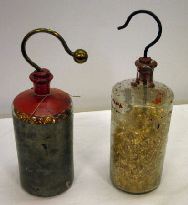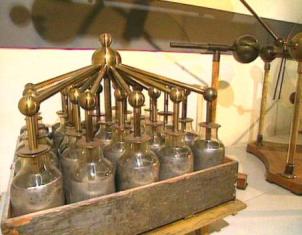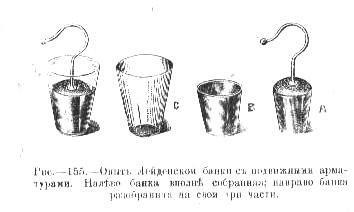Categories: Featured Articles » Interesting Facts
Number of views: 31167
Comments on the article: 1
Experimental collisions of the Leiden experience
 In 1913 Petersburg University received a new employee - physicist A.F. Ioffe. Under the specialty of a technologist engineer, with a penchant for scientific work, before that he had worked at the University of Munich for several years under the guidance of the best European experimental physicist V.K.Rentgen. There he defended his doctoral dissertation.
In 1913 Petersburg University received a new employee - physicist A.F. Ioffe. Under the specialty of a technologist engineer, with a penchant for scientific work, before that he had worked at the University of Munich for several years under the guidance of the best European experimental physicist V.K.Rentgen. There he defended his doctoral dissertation.
Now his physicist was O.D. Hvolson. In a conversation about upcoming research, this leader suggested that he "continue the wonderful tradition of Russian scientists" to reproduce the best scientific foreign work. It is clear that the student of X-ray, the very first Nobel laureate in physics, even to hear about it was strange. He asked again: "Isn't it better to raise new unresolved issues?" To which Hvolson replied: “But can anything new be invented in physics? To do this, you need to be GJ Thomson. ”
Indeed, J. Thomson, the discoverer of the electron, was a major physicist. But then it turned out that A.F. Ioffe also knew how to ask questions in science and the whole world semiconductor technology essentially began with it. In addition, he was the organizer of a Russian scientific school, whose students would be proud of any country in the world, including I.V. Kurchatov and Nobel laureates N.N. Semenov, P.L. Kapitsa.
The ability to ask nature questions and receive answers through experiment is considered the most important thing in the life of science. And the figures who know how to do this are just outstanding scientists. But she was also wrong and O.D. Hvolson. The foundation of modern physics consists of the findings of the work of pioneers, which are regularly checked, rechecked, refined. If the conclusions are not confirmed, entire sections of the sciences collapse, and then painstakingly erected new walls, branches of this science, which lead to new discoveries, to new constructions. Such a process lasts for centuries and there is no end to this.
Here we tell the story of an experiment by a scientist who was interested in a promising scientific question about a physical phenomenon and who tried to solve it with a simple and convincing experience, but which led to a situation called a collision. This is the case when the results obtained contradict each other.
No one can name the exact date of the scientific discovery of the fact that electric charges can be accumulated using special devices, later called Leiden banks and later developed in devices called electric capacitors. But it can be argued that after 1745. with the help of a Leyden jar, it was possible to find out the high speed of the spread of electricity, its effect on the human and animal organism, the possibility of igniting combustible gases with electric sparks, etc. Thousands of researchers are trying to use this device for the needs of the national economy. However, for some reason no one is trying to study the Leiden bank itself.
The first question to nature on the bank itself is asked by the great American self-taught scientist Benjamin Franklin. Recall that the Leyden jar at that time was an ordinary corked bottle of water, into the cork of which an iron rod was inserted that touched this water. The bottle itself was either held in hands or placed on a lead sheet. That was her whole device.
Franklin wondered to find out where in this simple device glass metal and water electricity can build up. In an iron rod, water or the bottle itself? Now, when there are various measuring instruments and half of the population uses computers, this question will perplex many.Let us see how this problem was solved in 1748, when the experimenter himself was the only measuring device, passing through himself painful electric shocks. For the most part, we will provide a description of the experiments by the author of the experiments himself, in order to verify their ingenious simplicity.
“Intending to examine the electrified jar in order to establish where its power is hidden, we placed it on the glass and took out the cork with the wire. Then, taking the can in one hand and raising the other finger to its neck, we removed a strong spark from the water with an equally strong blow, as if the wire remained in its place, and this showed that the force is not hidden in the wire. " Here, the author calls the lead terminal of the can a wire.
“After that, in order to find out if the electricity, as we thought, was not in the water, we again electrified the bank. Putting it on the glass, they took out of it, as before, a wire with a stopper; then we poured all the water from the can into an empty bottle, which also stood on the glass. We believed that if electricity was in the water, then when we touch this bottle we will get a hit. No blow came. From here we concluded that the electricity was either lost during the transfusion, or remained in the bank. ”
“The last one turned out to be true, as we established, because when testing this can, a blow followed, although we poured plain water from the kettle into it.” Franklin had no choice but to admit that the charge in the bank could only be in its glass.
“To find out then, this property is inherent in the glass of the bottle or its shape, we took a sheet of glass, laid it on the palm of our hand, covered it with a lead plate on top and electrified the latter. They brought a finger to her, resulting in a spark with a blow. " In this way, it was determined that the shape of the glass does not affect the result. The result of solving this problem was for Franklin the invention of a flat capacitor, one plate of which was the palm of the experimenter, and the other a sheet of lead. However, in the future he also replaces the palm of his hand with a lead sheet.
Who could have doubts about the scientific purity of the Yankee experiment? He could safely assert that in an electric capacitance “in a condensed form” the charge is in GLASS. If necessary, anyone could repeat these experiments and verify Franklin's conclusions. Surely such experiments were carried out and the conclusions were confirmed by many scientists. A demonstration model of the Leyden jar was even created, with the help of which they showed students a simplified version of the experiment, then they ended up with the wrong conclusion. After all, if instead of water, Franklin used mercury in the experiment, the result could be exactly the opposite.
The experiments with the Leyden jar were very spectacular and fully consistent with the ideas of enlightened absolutism, so they became fashionable in high society and even crowned persons took part in them. And the abbot J.A. Nollay even took up the post of official electrician under King Louis XV. He gave the name to the device on behalf of the university city of Leiden in Holland, where this device was most likely invented.
Ten years of experiments were not in vain. It was precisely established that the results of the experiments did not depend on the composition of the water (any one was suitable). Moreover, instead of water, a lead fraction could be poured into the jar, or simply lead foil was strengthened inside it. This was not reflected in the action of the can. To strengthen the action, banks learned to collect in batteries.

It was found that banks of a larger volume (therefore, with a larger glass surface) gave stronger discharges. But the dependence of the impact on the thickness of the glass was inverse. Thinner glasses gave a stronger discharge. Surprisingly, with the help of the researcher’s electric shock, scientists quite accurately came up with the well-known formula for the capacitance of a flat capacitor. Subsequently, historians of science jokingly call this measurement method a SOCKET METER.(From the French SHOCK - hit, push).
To explain electrical phenomena in the scientific community, several theories have been put forward that have found application among scientists. Among them was the unitary theory of electricity proposed by Franklin himself. According to this theory, electricity was a kind of weightless liquid that filled all bodies. If there was more or less of this fluid in the bodies, then the body acquired a charge. With an excess of this fluid, the body had a positive charge, with a deficiency - negative. This theory will later be developed in the electronic theory of conduction.
Using this theory, it was easy to explain the phenomena occurring in the capacitor (Leiden bank). When charging, an electric fluid flows from one capacitor plate to another. The result is a positive charge on one plate and a negative on another. The glass between them serves only as an insulator and nothing else. It is easy to discharge such a capacitor. It is enough to close these plates with a conductor or a human body. But the results of Franklin’s experience showed that the charge is in the glass! How to understand all this?
Some scientists, in order to confirm the correctness of the unitary theory, tried to remove glass from experience. They charged two metal bars that hung nearby. There is no doubt that they were a capacitor, but without glass. Alas, such an experimenter capacitor did not hit the current and the question remained unresolved.
In 1757, the work of the Russian academician Franz Epinus “Experience in the theory of electricity and magnetism” was published in St. Petersburg, which describes the experience that solved this problem. He took as his basis the idea that the electrification of the bars was correct, but the shock of the experimenter was not hit because of the small capacity of such a capacitor. And you can increase its capacity by increasing the capacitor plates and reducing the distance between them. Due to the fact that the experimenter invents a new type of electric capacitance for this experiment - a capacitor with an air dielectric, we give the text of F. Epinus himself.
"So, in order to get a large surface, I took care of making wooden plates, whose surface was about eight square feet, I hung them, overlaying metal sheets at a distance of one and a half inches from each other in a position parallel to one another." He charged such a capacitor and discharged through himself ..
“I immediately received a strong shock, completely similar to the one caused by the Leiden bank. In addition, this device was able to reproduce all other phenomena that are obtained in the bank; there is no need to overlook them. ” Note that eight square feet is a little less than a square meter.
The last remark about “all other phenomena” is very significant. It emphasizes that the electricity from such a capacitor is EXACTLY THE SAME as from the Leyden jar. But there was no glass, and to assume that the charges are in the surrounding air was unproductive. Later, in 1838, such substances “through or through which electric forces act” M. Faraday will call DIELECTRICS. Epinus makes a remark in the book: “I realized that something happened to Franklin that could happen to every person”, alluding to the Latin proverb - Errare humanum est - it is human nature to make mistakes.
F. Epinus sent his composition to America specifically for Franklin, but he almost stopped doing research on electricity, excluding the practical use of the lightning rod invented by him. He became a politician. And Catherine II was excommunicated from academic activity in Russia and F. Epinus. She appointed him a physics teacher for her son Paul, who later became emperor. But he was invited to St. Petersburg to replace G.V. Richman, who died during research on atmospheric electricity.It so happened that the question of experiments with a Leyden bank remained unresolved for a long time.
And in front of me is a textbook on electricity in 1918. publications. This is a translation of the book by the French author Georges Claude with the long title "Electricity for all and each clearly stated." It describes the experience with the Leyden jar, as in Franklin, but already in the absence of water at all. See picture.

On the left is the Leyden jar assembly. The letters A, B and C indicate its components. A and B are the inside and outside of the can. C is a glass beaker serving as an insulator. Such a can assembly is charged during a demonstration experiment, then a charged can is disassembled by a demonstrator in rubber gloves. To prove the fact that the can linings do not have a charge, they are in contact with each other. Make sure there is no spark. Then the jar is collected. Surprisingly, it is again charged and gives a powerful spark. This experience baffled many. And science does not suffer from ambiguities. However, an explanation of the situation was given only in 1922.
In that year, in the London Philosophical Journal, an article was published by physicist J. Addenbrook, “Studying Franklin’s experiments with a Leyden jar,” where the author came up with amazing results that dotted all i. It turns out that under normal conditions glass is always covered with a water film, we observe this by fogging the windows. By the way, this film is not always observed visually. And there the charges on the disassembled capacitor remain and play the role of plates in a stand-alone glass. When Addenbrook uses a glass not of glass, but of paraffin, on which a glass film does not form, the result is the opposite of Franklin's. In a dry atmosphere, the "Franklin effect" on a collapsible Leiden bank is also not observed.
See also at e.imadeself.com
:
